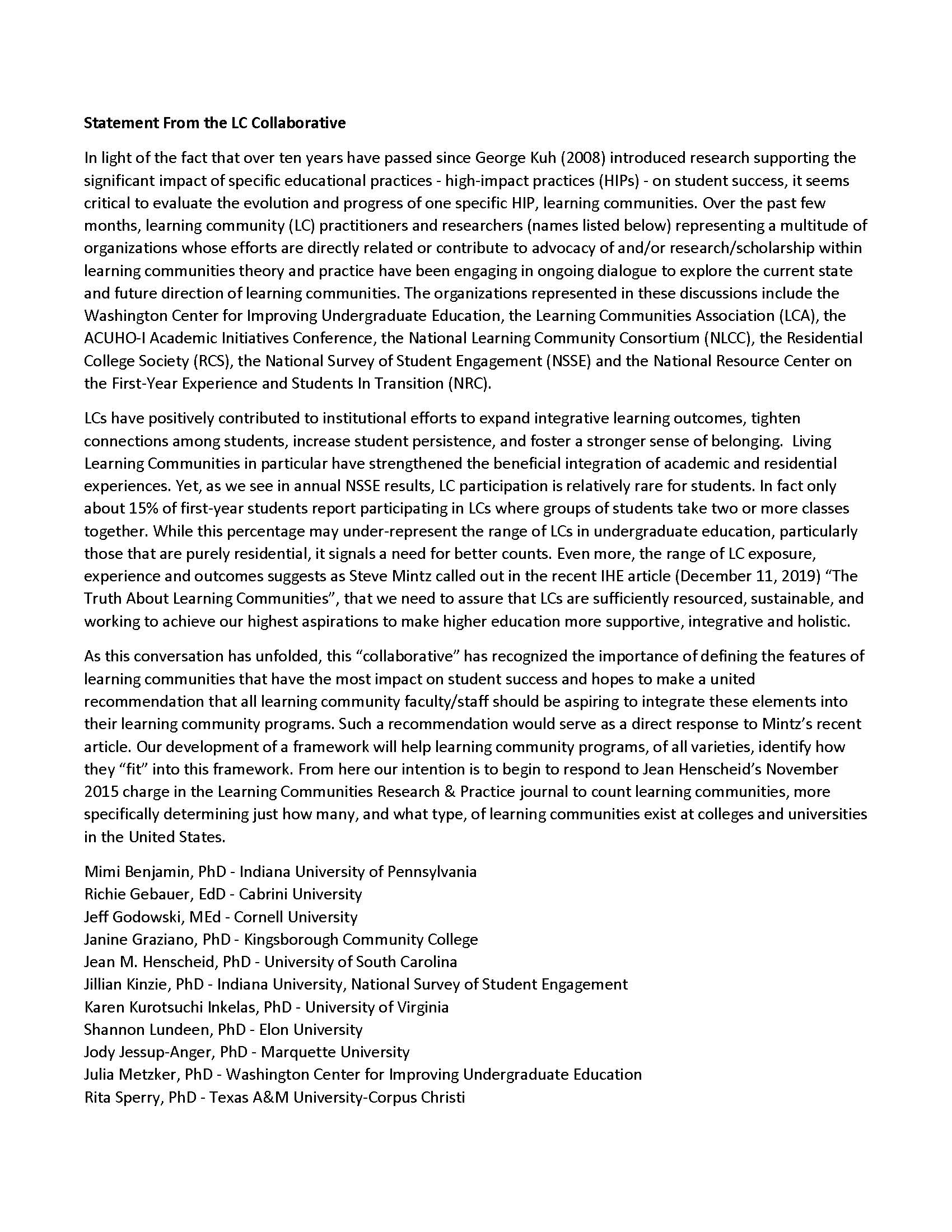You have /5 articles left.
Sign up for a free account or log in.
Welcome to this week's edition of "Transforming Teaching and Learning," a column that explores how colleges and professors are reimagining how they teach and how students learn. Please share your ideas here for issues to examine, hard questions to ask and experiments -- successes and failures -- to highlight. If you'd like to receive the free "Transforming Teaching and Learning" newsletter, please sign up here. And please follow us on Twitter @ihelearning.
***
If you’re a fan of learning communities -- a “high-impact” educational practice that more and more colleges and universities are adopting -- Steve Mintz’s blog post on the subject on Inside Higher Ed late last year could have felt like a punch in the gut.
The essay, headlined “The Truth About Learning Communities,” mostly explored the various approaches colleges and universities take to learning communities, an increasingly popular student success strategy. The approach engages groups of (typically) first-year students in a set of educational and co-curricular experiences (and sometimes living arrangements) around a common theme, question or career goal.
But in addition to laying out the learning communities landscape, Mintz's essay opened and closed with the warning: calling something a rose doesn’t make it one.
His conclusion said:
Learning communities speak to our highest aspirations: to make higher education less transactional and more developmental, supportive, integrative and holistic. But we mustn’t let our language obscure reality. Much as the Holy Roman Empire was (in Voltaire’s words) neither holy, nor Roman, nor an empire, we mustn’t call a weed a rose.
One could read that last sentence to suggest that Mintz, a nationally known cultural historian with a bent for curricular innovation, thinks learning communities are a fad or, worse, a fraud.
His comments definitely got the attention of the academics in what we might call the learning community community -- but they on the whole read Mintz’s essay as a caution and a challenge, not an insult.
“The range of [learning community] exposure, experience and outcomes suggests, as Steve Mintz called out in the recent IHE article … that we need to assure that LCs are sufficiently resourced, sustainable, and working to achieve our highest aspirations,” a group of researchers and educators calling itself the Learning Community Collaborative said in a statement about their work (see box below).
Or, as one member of the collaborative put it in an interview last week: bad learning communities "do more harm than good … so how do we ensure that what campuses are doing are truly learning communities?"
***
Learning communities -- the concept and the phrase -- have been around in one form or another for a long time, so in some ways 2020 seems a little late for a discussion about what they are, how many campuses have them and the like.
But like many things in higher education, it's arguably only in the last decade-plus that learning communities -- like some of the other "high-impact practices" that George Kuh and other researchers on student learning have documented -- have moved into the mainstream. And it's a similarly recent phenomenon that colleges and universities are facing intensifying pressure to ensure that as many students as possible succeed to the fullest extent possible, and to shrink if not eliminate gaps in attainment by different racial and socioeconomic groups.
In response to the push for "student success," many colleges are adopting strategy after strategy, tactic after tactic, to both try to improve their students' actual success and, Mintz says, to show, to signal, that they are trying.
Mintz does not doubt that many of the institutions implementing learning communities are doing so with that first purpose in mind -- helping students.
Learning communities do that, he writes, by "connecting students with peers and making the first-year curriculum more coherent, cohesive, synergistic and relevant to students’ interests and aspirations." Done right, they must be more than clusters of linked classes; the involved faculty members must work together to create an "integrated educational experience," collaborating on "defining learning outcomes, selecting content and readings, and designing assignments and assessments."
Some of the elements are especially important for first-generation and other less experienced students, Mintz says. Putting students into a cohort and into study groups is important because "many first-generation students believe in a pull-yourself-up-by-the-bootstraps, I-can-do-it-myself mode," but for many such students, "that's a recipe for failure."
Linking a group of courses together so students see the connections between them helps "create a more integrated intellectual experience" that gives students "academic momentum," and it's essential to build in co-curricular activities "apart from the academic if [students] are going to have any degree of mental health."
Falling Short
Some institutions, though, take shortcuts, Mintz says in an interview, "assigning students to five classes and declar[ing] it has some theme, but they're the same classes that existed in the past." For others it's an administrative convenience, "not a community in any sense at all, with the professors never consulted at all about common projects or themes, and there's no intentional design, no leader."
“Often you’re marketing to accreditors, to peer institutions -- ‘we have learning communities,’” he says.
Mintz, who is spending this year at the City University of New York's Hunter College as senior adviser to the president for student success and special initiatives, is careful to say that he doesn't want to "pit perfection against the possible."
"People can only do what their institutions can do," he says. There's a reason, Mintz adds, that "no university since 1945 has adopted Columbia [University's] core" curriculum, which requires the kinds of faculty, staff and other resources that only places like Columbia and the University of Chicago can afford.
And even an imperfect, less-than-ideal learning community may well be "better than what those students were getting before," Mintz says, as any "more structured first-year experience is going to make them better off."
But learning communities that are a "charade" benefit no one, he writes.
***
Rita Sperry bristled the first time she read Mintz's blog post on Inside Higher Ed. "I saw it as a little bit of an indictment of what we do," says Sperry, associate dean of University College and coordinator of the first-year learning communities program at Texas A&M University Corpus Christi.
But as she re-read and discussed it with colleagues (including those in the Learning Community Collaborative), she says, "We realized he's saying a lot of the same things we feel. There are programs out th ere that call themselves learning communities that are learning communities in name only.
ere that call themselves learning communities that are learning communities in name only.
"So now we're using it as a challenge for our faculty and myself, to make sure that we're not a learning community in name only."
Texas A&M Corpus Christi, a Hispanic-serving institution where a majority of students are first-generation college goers, requires all of its students to participate in a curriculum-based (as opposed to residential) learning community of their choice in their first two semesters. All of the learning communities include a first-year seminar and at least one other course, with instructors for the courses meeting regularly to coordinate their teaching plans and integrate their assignments.
Sperry is confident that the 25-year-old program successfully integrates learning for participating students. "It's helping students pull together the things they're learning," she says.
But "some people at our institution feel it's just a fad," Sperry says. "Others don't know if it's worth the effort." And she acknowledges that it's hard to judge the program's impact because its required nature means there's no control group of Corpus Christi students who aren't in a learning community.
That's why Sperry got involved in the Learning Community Collaborative, which describes its mission as “defining the features of learning communities that have the most impact on student success and … mak[ing] a united recommendation that all learning community faculty/staff should be aspiring to integrate these elements into their learning community programs.”
"I feel like we do need to do a lot more research on learning communities and the qualities that make them successful," she says. Having that body of work might satisfy the doubters on her campus -- some of whose concerns were captured in Mintz's blog post.
***
Richie Gebauer is executive director for the first-year experience and student transitions at Cabrini University, in Pennsylvania, and president of the Learning Communities Association, which was founded in 2017.
He shares Mintz's worry that "a lot of institutions are trying to develop and offer these opportunities to be competitive in the marketplace, but whether or not they have true impactfulness, I'm not sure that's the case," he says. Colleges have "flooded the market" with programs they call learning communities, but some of the programs are "diluted" -- they don't intentionally integrate the courses and the instructors who teach them, have a clear leader, etc.
Can that harm students? Is participation in a lesser learning community -- a diluted one, to use Gebauer's word -- worse than being in none at all?
"No, I think there's probably some type of positive impact there," he says. "I don't know if it’s measurable, but based on the fact you have a group of peers working together in some capacity, there's probably some impact, though it may be minimal."
The bigger fear, he says, is that "when learning communities that are diluted, that aren't having the sort of profound impact that we feel, and that research shows, truly integrative learning communities are having, it hurts institutions that are doing more integrative type of work and contributes to the idea that they're a fad."
That's why aligning the wide range of experts and leaders of the "siloed" groups that focus on learning communities into one common organization makes sense, Gebauer, Sperry and others in the Learning Community Collaborative say.
"We're trying in an informal way to establish a standard for what these learning communities should look like, what type of effort and time and energy needs to be put into them to make them substantial, and what's really impactful," Gebauer says.
Gebauer insists that the effort to define a standard is "not about excluding programs that are saying they're doing learning communities but are not truly integrative."
“It’s about giving institutions the information they need to strive for,” he adds. “We’ll want them to say, ‘If we’re missing these elements, these characteristics, how do we think we might develop and design those?’”
Shockingly, nobody I spoke to for this article acknowledged having the sort of "lesser than" learning community that Mintz called out. (Gebauer laughed when I asked him if there's an association of "diluted" learning community programs.)
But they're clearly out there. Gebauer recalled a learning community workshop a few years ago where he and some colleagues pointed out to officials of one college that their learning community appeared to be mainly a way to house students rather than to actually give them an integrative, connective learning experience.
“It was really hard for them to hear, and the team leader pushed back hard and let us have it,” he says. “But after letting it sink in, she came back and said, ‘You’re right.’ They’re now doing some really great work and have a clear understanding of where they’re going.”
He adds, "If we do this right, we'll help everyone raise the bar, and the work nationally just improves."
Nothing would make Steve Mintz happier.








